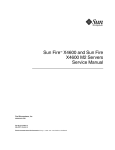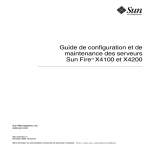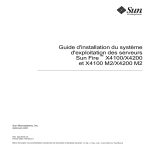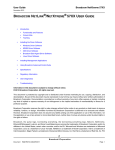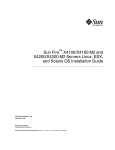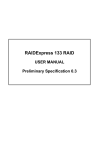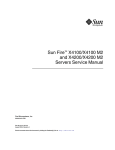Download Dell SCSI 6/IR User's Manual
Transcript
book.book Page 1 Wednesday, July 25, 2007 10:58 AM Dell™ Serial-Attached SCSI 6/iR Integrated and Adapter User’s Guide w w w. d e l l . c o m | s u p p o r t . d e l l . c o m book.book Page 2 Wednesday, July 25, 2007 10:58 AM Notes, Notices, and Cautions NOTE: A NOTE indicates important information that helps you make better use of your computer. NOTICE: A NOTICE indicates either potential damage to hardware or loss of data and tells you how to avoid the problem. CAUTION: A CAUTION indicates a potential for property damage, personal injury, or death. ____________________ Information in this document is subject to change without notice. © 2007 Dell Inc. All rights reserved. Reproduction in any manner whatsoever without the written permission of Dell Inc. is strictly forbidden. Trademarks used in this text: Dell, the DELL logo, Dell Precision, PowerEdge, and OpenManage are trademarks of Dell Inc.; Intel is a registered trademark of Intel Corporation; Microsoft, Windows, Windows Server, and Windows Vista are either trademarks or registered trademarks of Microsoft Corporation in the United States and/or other countries; Novell, NetWare, and SUSE are registered trademarks of Novell, Inc. in the United States and other countries; Red Hat Linux and Red Hat Enterprise Linux are registered trademarks of Red Hat, Inc.; LSI Logic, Fusion-MPT, Integrated Mirroring, and Integrated Striping are trademarks or registered trademarks of LSI Logic Corporation; DR-DOS is a registered trademark of DRDOS, Inc. Other trademarks and trade names may be used in this document to refer to either the entities claiming the marks and names or their products. Dell Inc. disclaims any proprietary interest in trademarks and trade names other than its own. Model UCS-61 August 2007 P/N JM360 Rev. A00 book.book Page 3 Wednesday, July 25, 2007 10:58 AM Contents CAUTION: Safety Instructions . SAFETY: General . . . . . . . . . . . . . . . . . . . . . . . . . . . . . . . . . . . . . . . . . . . . . . . . . . . . . . SAFETY: When Working Inside Your System . . . . . . . . . . . . . . . . . . . SAFETY: Protecting Against Electrostatic Discharge . 1 7 7 8 Overview . . . . . . . . . . . . . . . . . . . . . . . . . . . . . . . . . . . 9 About RAID . . . . . . . . . . . . . . . . . . . . . . . . . . . . . . . . . . . . 10 RAID Levels . . . . . . . . . . . . . . . . . . . . . . . . . . . . . . . . . 10 RAID Terminology . . . . . . . . . . . . . . . . . . . . . . . . . . . . . . . . 10 . . . . . . . . . . . . . . . . . . . . . . . . . . . . 10 11 . . . . . . . . . . . . . . . . . . . . . . . . . . . . . 13 Integrated Striping . Integrated Mirroring . . . . . . . . . . . . . . . . . . . . . . . . . . . . 2 SAS 6/iR Features 3 Hardware Installation . . . . . . . . . . . . . . . . . . . . . . . . . . Installing the SAS 6/iR Adapter 4 . . . . . . . . . . . . . . 7 Driver Installation 15 . . . . . . . . . . . . . . . . . . . . . . . . . 15 . . . . . . . . . . . . . . . . . . . . . . . . . . . . . 19 Creating a Driver Diskette . . . . . . . . . . . . . . . . . . . . . . . . . . . . Installing the Driver During Windows Operating System Installation . . . . . 20 . . . . . . . . . . 20 . . . . . . . . . . . . . . . . . . . . . 21 Installing a Windows Driver for a New SAS 6/iR Controller Updating an Existing Windows Driver 19 Installing From the Dell Operating System Media . . . . . . . . . . . . . . . 22 Contents 3 book.book Page 4 Wednesday, July 25, 2007 10:58 AM Installing the Red Hat Linux Driver . . . . . . . . . . . . . . . . . . . . . . . Creating a Driver Diskette . . . . . . . . . Installing the Driver . . . . . . . . . . . . . Installing the Driver Using an Update RPM. . . . . . . . . . . . . . . . . . . . . . . . . . . . . . . . . 22 23 23 . . . . . . . . . . . . . . 24 Installing the Driver Using an Update RPM. . . Installing SUSE Linux Enterprise Server Using the Driver Update Diskette . . . . . . . . . . . . . . . . . . . . . . . . . 24 . . . . . . . . . . . . . . 25 . . . . . . . . . . . . . . . . . . . . . . . . . . . . . . 26 . . . . . . . . . . . . . . . . . . . . . . . . . . . . . . . 27 . . . . . . . . . . . . . . . . . . . . . . . . . . . . . . . . . 27 SAS 6/iR BIOS . POST Messages . . . . . . . . . . . . . . . . . . . . . . . . 27 . . . . . . . . . . . . . . . . . . . . . . . . . . . . . . . 28 BIOS Fault Code Messages . Configuration Utility Starting the Configuration Utility . . Functions Performed . . . . . . . . Navigating the Configuration Utility . . . . . . . . . . . . . . . . . . . . . . . . . . . . . . . . . . . . . . . . . . . . . . . . . . . . . . . . . . . . Integrated RAID Configuration and Management Screens . Select New Array Type . Create New Array . . . . View Array . . . . . . . Manage Array . . . . . . Exit Screen . . . . . . . . . . . . . . . . . 29 29 29 31 31 31 . . . . . . . . . . . . . . . . . . . . . . . . . . . . . . . . . . . . . . . . . . . . . . . . . . . . . . . . . . . . . . . . . . . . . . . . . . . . . . . . . . . . . . . . . . . . . . . . . . . . . . . . . . . . . . . . . . . . . . . . . . . . . . . . Creating an Integrated Striping Virtual Disk . . . . Creating a Integrated Mirroring Virtual Disk . . . . Viewing Virtual Disk Properties . . . . . . . . . . . Synchronizing a Virtual Disk . . . . . . . . . . . . Activating a Virtual Disk . . . . . . . . . . . . . . Deleting a Virtual Disk . . . . . . . . . . . . . . . Hot Spare Failover . . . . . . . . . . . . . . . . . Replacing and Rebuilding a Degraded Virtual Disk Contents 28 28 29 . . . . . . . . . . . . . . . . . . . . . . . . . . Performing Configuration Tasks . 4 22 Installing the SUSE Linux Enterprise Server Driver . Upgrading the Kernel 5 . . . . . . . . . . . . . . . . . . . . . . . . . . . . . . . . . . . . . . . . . . . . . . . . . . . . . . . . . . . . . . . . . . . . . . . . . . . . . . . . . . . . . . . . . . . . . . . . . . . . . . . . . . . . . . . . 32 32 33 34 34 34 35 35 35 book.book Page 5 Wednesday, July 25, 2007 10:58 AM 6 Troubleshooting BIOS Boot Order . . . . . . . . . . . . . . . . . . . . . . . . . . . . . . 37 . . . . . . . . . . . . . . . . . . . . . . . . . . . . . . . . . 37 General Problems . . . . . . . . . . . . . . . . . . . . . . . . . . . . . . . . Physical Disk Related Issues . . . . . . . . . . . . . . . . . . . . . . . . . . 39 . . . . . . . . . . . . . . . . . . . . . . . . . . . . . . 40 A Updating the Firmware . . . . . . . . . . . . . . . . . . . . . . . . . . 43 . . . . . . . . . . . . . . . . . . . . . . . . . . . . . 43 . . . . . . . . . . . . . . . . . . . . . . . . . . . . . . . . . 45 Firmware Update Utility B Getting Help Obtaining Assistance . . . . . . . . . . . . . . . . . . . . . . . . . . . . . . Dell Enterprise Training . . . . . . . . . . . . . . . . . . . . . . . . . . . . . . . . . . . . . . . . . . . . . . 47 . . . . . . . . . . . . . . . . . . . . . . . . . . . . . . . . . . . . . . . . . . . . . . . . . . . . . . . . . . . . . 47 . . . . . . . . . . . . . . . . . . . . . . . . . . . . . . . 47 Problems With Your Order . Product Information . . . . . . . . . . . . . . . . . 47 . . . . . . . . . . . . . . . . . . . . . . . . . . . . . . . . . 48 Returning Items for Warranty Repair or Credit C Regulatory Notices . . . . . . . . . . . . . . . . . . . . . . . . . . . . 49 . . . . . . . . . . . . . 53 . . . . . . . . . . . . . . . . . . . . . . . . . . . . . . . . . . . . . . 55 . . . . . . . . . . . . . . . . . . . . . . . . . . . . . . . . . . . . . . . . 61 D Corporate Contact Details (Taiwan Only) Glossary Index . 45 45 46 46 Technical Support and Customer Service Online Services . . . . . . . . . . . . . . Automated Order-Status Service . . . . . Before You Call . 38 . . . . . . . . . . . . . . . . . . . . . . Configuration Utility Error Messages BIOS Error Messages 37 Contents 5 book.book Page 6 Wednesday, July 25, 2007 10:58 AM 6 Contents book.book Page 7 Wednesday, July 25, 2007 10:58 AM CAUTION: Safety Instructions Use the following safety guidelines to help ensure your own personal safety and to help protect your system and working environment from potential damage. NOTE: See the caution and safety statements in your Dell™ PowerEdge™ system or Dell Precision™ workstation. SAFETY: General • Observe and follow service markings. Do not service any product except as explained in your user documentation. Opening or removing covers that are marked with the triangular symbol with a lightning bolt may expose you to electrical shock. Components inside these compartments should be serviced only by a trained service technician. • If any of the following conditions occur, unplug the product from the electrical outlet and replace the part or contact your trained service provider: – The power cable, extension cable, or plug is damaged. – An object has fallen into the product. – The product has been exposed to water. – The product has been dropped or damaged. – The product does not operate correctly when you follow the operating instructions. • Use the product only with approved equipment. • Operate the product only from the type of external power source indicated on the electrical ratings label. If you are not sure of the type of power source required, consult your service provider or local power company. • Handle batteries carefully. Do not disassemble, crush, puncture, short external contacts, dispose of in fire or water, or expose batteries to temperatures higher than 60 degrees Celsius (140 degrees Fahrenheit). Do not attempt to open or service batteries; replace batteries only with batteries designated for the product. SAFETY: When Working Inside Your System Before you remove the system covers, perform the following steps in the sequence indicated. CAUTION: Except as expressly otherwise instructed in Dell documentation, only trained service technicians are authorized to remove the system cover and access any of the components inside the system. NOTICE: To help avoid possible damage to the system board, wait 5 seconds after turning off the system before removing a component from the system board or disconnecting a peripheral device. 1 Turn off the system and any devices. 2 Ground yourself by touching an unpainted metal surface on the chassis before touching anything inside the system. 3 While you work, periodically touch an unpainted metal surface on the chassis to dissipate any static electricity that might harm internal components. 4 Disconnect your system and devices from their power sources. To reduce the potential of personal injury or shock, disconnect any telecommunication lines from the system. Safety Instructions 7 book.book Page 8 Wednesday, July 25, 2007 10:58 AM In addition, take note of these safety guidelines when appropriate: • When you disconnect a cable, pull on its connector or on its strain-relief loop, not on the cable itself. Some cables have a connector with locking tabs; if you are disconnecting this type of cable, press in on the locking tabs before disconnecting the cable. As you pull connectors apart, keep them evenly aligned to avoid bending any connector pins. Also, before you connect a cable, make sure that both connectors are correctly oriented and aligned. • Handle components and cards with care. Do not touch the components or contacts on a card. Hold a card by its edges or by its metal mounting bracket. Hold a component such as a microprocessor chip by its edges, not by its pins. SAFETY: Protecting Against Electrostatic Discharge Electrostatic discharge (ESD) events can harm electronic components inside your computer. Under certain conditions, ESD may build up on your body or an object, such as a peripheral, and then discharge into another object, such as your computer. To prevent ESD damage, you should discharge static electricity from your body before you interact with any of your computer’s internal electronic components, such as a memory module. You can protect against ESD by touching a metal grounded object (such as an unpainted metal surface on your computer’s I/O panel) before you interact with anything electronic. When connecting a peripheral (including handheld digital assistants) to your computer, you should always ground both yourself and the peripheral before connecting it to the computer. In addition, as you work inside the computer, periodically touch an I/O connector to remove any static charge your body may have accumulated. You can also take the following steps to prevent damage from electrostatic discharge: 8 • When unpacking a static-sensitive component from its shipping carton, do not remove the component from the antistatic packing material until you are ready to install the component. Just before unwrapping the antistatic package, be sure to discharge static electricity from your body. • When transporting a sensitive component, first place it in an antistatic container or packaging. • Handle all electrostatic sensitive components in a static-safe area. If possible, use antistatic floor pads and work bench pads. Safety Instructions book.book Page 9 Wednesday, July 25, 2007 10:58 AM Overview The Dell™ Serial-Attached SCSI (SAS) 6/iR controller is Dell’s next generation controller with integrated redundant array of independent disks (RAID) capabilities. SAS technology is not backward compatible with the previous generation of SAS or SCSI devices. The SAS 6/iR Adapter is a half-length, standard-height PCI-E card, while the SAS 6/iR Integrated is embedded in the platform hardware. The SAS 6/iR Adapter is supported on platforms with PCI-E x8 or x16 connectors. Figure 1-1. SAS 6/iR Adapter Hardware Architecture 1 2 1 SAS x4 internal connector 2 PCI-E connector Overview 9 book.book Page 10 Wednesday, July 25, 2007 10:58 AM About RAID RAID is a group of multiple independent physical disks that provide high performance by increasing the number of drives used for saving and accessing data. A RAID disk subsystem improves I/O performance and data availability. The physical disk group appears to the host system as a single storage unit or as multiple logical units. Data throughput improves because multiple disks can be accessed simultaneously. RAID systems also improve data storage availability and fault tolerance. RAID Levels Integrated Striping or RAID 0 uses disk striping to provide high data throughput, especially for large files in an environment that requires no data redundancy. Integrated Mirroring or RAID 1 uses disk mirroring so that data written to one physical disk is simultaneously written to another physical disk. This is good for small databases or other applications that require small capacity, but complete data redundancy. NOTICE: Lost data on an Integrated Striping virtual disk cannot be recovered in the event of a physical disk failure. RAID Terminology Integrated Striping Integrated Striping (RAID 0) allows you to write data across multiple physical disks instead of just one physical disk. Integrated Striping involves partitioning each physical disk storage space into 64 KB stripes. These stripes are interleaved in a repeated sequential manner. The part of the stripe on a single physical disk is called a stripe element. For example, in a four-disk system using only Integrated Striping, segment 1 is written to disk 1, segment 2 is written to disk 2, and so on. Integrated Striping enhances performance because multiple physical disks are accessed simultaneously, but Integrated Striping does not provide data redundancy. Figure 1-2 shows an example of Integrated Striping. Figure 1-2. Example of Integrated Striping (RAID 0) Stripe element 1 Stripe element 5 Stripe element 9 10 Overview Stripe element 2 Stripe element 6 Stripe element 10 Stripe element 3 Stripe element 7 Stripe element 11 Stripe element 4 Stripe element 8 Stripe element 12 book.book Page 11 Wednesday, July 25, 2007 10:58 AM Integrated Mirroring With Integrated Mirroring (RAID 1), data written to one disk is simultaneously written to another disk. If one disk fails, the contents of the other disk can be used to run the system and rebuild the failed physical disk. The primary advantage of Integrated Mirroring is that it provides 100 percent data redundancy. Because the contents of the disk are completely written to a second disk, it does not matter if one of the disks fails. Both disks contain the same data at all times. Either physical disk can act as the operational physical disk. NOTE: Mirrored physical disks improve read performance by read load balance. Figure 1-3. Example of Integrated Mirroring (RAID 1) Stripe element 1 Stripe element 2 Stripe element 3 Stripe element 4 Stripe element 1 Duplicated Stripe element 2 Duplicated Stripe element 3 Duplicated Stripe element 4 Duplicated Overview 11 book.book Page 12 Wednesday, July 25, 2007 10:58 AM 12 Overview book.book Page 13 Wednesday, July 25, 2007 10:58 AM SAS 6/iR Features This section provides the specifications of Dell™ Serial-Attached SCSI (SAS) 6/iR controller. The following table compares the specifications of the SAS 6/iR Adapter and SAS 6/iR Integrated. Table 2-1. Specifications of SAS 6/iR Specification SAS 6/iR Adapter SAS 6/iR Integrated SAS technology Yes Yes Support for x4, x8, or x16 PCI Express Host Interface Yes Yes Form Factor Standard-Height, Half-Length PCI Adapter System dependent LSI SAS 1068e LSI SAS 1068e Core Speed: 255 MHz Core Speed: 255 MHz Operating voltage requirements +12V, +3.3V, +3.3Vaux +12V, +3.3V, +3.3Vaux Communication to the system PCI-E lanes System dependent Communication to end devices SAS Links SAS Links SAS Connectors 2 x4 Internal System dependent Lead Free Yes I/O controller (IOC) Microsoft® Yes Server® 2003 Windows Family, Windows® XP, Windows Vista™ Business 32BIT and Business 64BIT, Red Hat® Enterprise Linux® Versions 4 and 5, SUSE® Linux Enterprise Server Version 10. Microsoft Windows Server 2003 Family, Windows XP, Windows Vista Business 32BIT and Business 64BIT, Red Hat Enterprise Linux Versions 4 and 5, SUSE Linux Enterprise Server Version 10. Windows Miniport Interface Storport, SCSIport (Windows XP 32-bit only) Storport, SCSIport (Windows XP 32-bit only) Supported drivers for Linux Yes Yes Dell-compliant SAS and SATA compatibility Yes Yes Dell-compliant physical disks Dell-compliant physical disks Supported operating systems Dell supported direct connected end devices SAS 6/iR Features 13 book.book Page 14 Wednesday, July 25, 2007 10:58 AM Table 2-1. Specifications of SAS 6/iR (continued) Specification 14 SAS 6/iR Adapter SAS 6/iR Integrated Hot add / Hot remove of end devices Yes System dependent SMART error support through management applications Yes Yes Backplane supported systems Yes Yes Hardware-based RAID RAID 0, RAID 1 RAID 0, RAID 1 Maximum number of virtual disks 2 2 Storage management software OpenManage™ Storage Services, SAS RAID Storage Manager OpenManage Storage Services, SAS RAID Storage Manager Support for internal tape drive No No Support for Hotspare Yes Yes Maximum number of Hotspares 2 2 SAS 6/iR Features book.book Page 15 Wednesday, July 25, 2007 10:58 AM Hardware Installation This chapter describes how to install the Dell™ Serial-Attached SCSI (SAS) 6/iR Adapter. NOTE: The SAS 6/iR Integrated is embedded on the system motherboard and does not require any installation. See your system’s Hardware Owner’s Manual or the User’s Guide for instructions. Installing the SAS 6/iR Adapter CAUTION: For some systems, only trained service technicians are authorized to remove the system cover and access any of the components inside the system. Before performing any procedure, see your Product Information Guide for complete information about safety precautions, working inside the computer, and protecting against electrostatic discharge. 1 Unpack the SAS 6/iR Adapter and check for damage. NOTE: Contact Dell if the controller is damaged. 2 Turn off the system and attached peripherals, and disconnect the system from the electrical outlet. See your system’s Hardware Owner’s Manual or the User’s Guide for more information on power supplies. 3 Disconnect the system from the network and remove the cover of the system. See your system’s Hardware Owner’s Manual or the User’s Guide for more information on opening the system. 4 Select an appropriate PCI-E slot. Remove the blank filler bracket on the back of the system aligned with the PCI-E slot you have selected. NOTE: For more information about your system’s PCI-E slots, see your system’s Hardware Owner’s Manual. 5 Align the SAS 6/iR Adapter to the PCI-E slot you have selected. 6 Insert the controller gently, but firmly, until the controller is firmly seated in the PCI-E slot. See Figure 3-1. Hardware Installation 15 book.book Page 16 Wednesday, July 25, 2007 10:58 AM Figure 3-1. Installing a SAS 6/iR Adapter 1 4 2 5 3 1 bracket screw 2 SAS 6/iR Adapter 4 PCI bracket 5 filler bracket 3 PCI-E slot 7 Tighten the bracket screw, if any, or use the system’s retention clips to secure the controller to the system’s chassis. 8 Connect the cables from the end devices or the backplane of the system to the controller. See Figure 3-2. 16 Hardware Installation book.book Page 17 Wednesday, July 25, 2007 10:58 AM Figure 3-2. Connecting the Cable 3 2 1 SAS 6/iR Adapter 1 2 SAS x4 internal connector 3 cable 9 Replace the cover of the system. See your system’s Hardware Owner’s Manual or the User’s Guide for more information on closing the system. 10 Reconnect the power cable(s) and network cables, and then turn on the system. Hardware Installation 17 book.book Page 18 Wednesday, July 25, 2007 10:58 AM 18 Hardware Installation book.book Page 19 Wednesday, July 25, 2007 10:58 AM Driver Installation The Dell™ Serial-Attached SCSI (SAS) 6/iR controller requires software drivers to operate with Microsoft® Windows®, Red Hat® Linux®, and SUSE® Linux operating systems. This chapter contains the procedures for installing the drivers for the following operating systems: • Microsoft Windows Server® 2003 Server family. • Microsoft Windows XP. • Red Hat Linux Versions 4 and 5. • SUSE Linux Enterprise Server Version 10. • Windows Vista™. The four methods for installing a driver that are discussed in this chapter are: • During operating system installation. • After adding a new SAS 6/iR controller on an existing operating system. • Updating existing drivers. • Installing from a Dell Precision™ Workstation Operating System CD or DVD. This media includes the drivers. NOTE: Operating system installation on an Integrated Mirroring or Integrated Striping virtual disk is supported only when the virtual disk is in an optimal state. NOTE: Device drivers are frequently updated. To ensure you have the latest version of any driver mentioned in this section, check the Dell Support website at support.dell.com. If a newer version exists, you can download the driver to your system. Creating a Driver Diskette NOTE: Driver diskette is not needed if you are installing from a Dell Precision™ Workstation Operating System CD or DVD. 1 Browse to the download section of the system on the Dell Support website at support.dell.com. 2 Locate and download the latest SAS 6/iR driver for the system. The drivers are packaged on the Dell Support website such that they can be written onto a diskette. 3 Follow the instructions on the support site for extracting the driver to the diskette. Driver Installation 19 book.book Page 20 Wednesday, July 25, 2007 10:58 AM Installing the Driver During Windows Operating System Installation NOTE: You do not need to provide a driver to install the Windows Vista operating system as the driver is native to this operating system. To install the driver during Windows operating system installation: 1 Boot the system using the Microsoft® Windows Installation CD. 2 When the message Press F6 if you need to install a third party SCSI or RAID driver appears, press <F6> immediately. Within a few minutes, a screen appears that asks for additional controllers in the system. NOTE: This step is not required for systems running Windows Vista. 3 Press <S>. The system prompts for the driver diskette to be inserted. 4 Insert the driver diskette in the diskette drive and press <Enter>. A list of SAS 6/iR drivers appears. 5 Select the appropriate driver and press <Enter> to load the driver. NOTE: For some Windows operating systems, a message may appear that states that the driver you provided is older/newer than the Windows driver. Press <S> to use the driver that is on the floppy diskette. 6 Press <Enter> again to continue the installation. Installing a Windows Driver for a New SAS 6/iR Controller NOTE: You do not need to provide a driver to install the Windows Vista operating system as the driver is native to this operating system. To configure the driver when you add the SAS 6/iR controller to a system that already has Windows installed: 1 Turn off the system. 2 Install the new SAS 6/iR controller in the system. See "Hardware Installation" on page 15 for detailed instructions on installing and cabling the SAS 6/iR controller. 3 Turn on the system. The Windows operating system should detect the new controller and display a message to inform the user. NOTE: For systems with Windows Vista, the new controller is configured using the native driver. To ensure you have the latest version of this driver, check the Dell Support website at support.dell.com. If a newer version exists, you can download the driver to your system. 20 Driver Installation book.book Page 21 Wednesday, July 25, 2007 10:58 AM 4 The Found New Hardware wizard appears and displays the detected hardware device. NOTE: In some Windows operating systems, the initial Found New Hardware screen may request to connect to the Internet in order to find the appropriate driver for the found device. Select No, not at this time. 5 Click Next. 6 On the Locate device driver screen, select Search for a suitable driver for my device and click Next. 7 Provide the appropriate driver package (from your driver diskette) on the Locate Driver Files screen. 8 Click Next. 9 The wizard detects and installs the appropriate device drivers for the new SAS 6/iR controller. 10 Click Finish to complete the installation. 11 Restart the system. Updating an Existing Windows Driver To update the Windows driver for the SAS 6/iR controller already installed on your system: NOTE: It is important that you close all applications on your system before you update the driver. 1 Click Start→ Control Panel→ System. The System Properties screen appears. NOTE: In some Windows operating systems, click Start→ Settings→ Control Panel→ System. 2 Click on the Hardware tab. 3 Click Device Manager. The Device Manager screen appears. 4 Double-click on SCSI and RAID Controllers (Storage Controller in Windows Vista). 5 Double-click the SAS 6/iR controller for which you want to update the driver. 6 Click the Driver tab and click on Update Driver. The Update Device Driver wizard appears. 7 Insert the appropriate driver diskette. 8 Select Install from a list or specific location. 9 Click Next. 10 Follow the steps in the wizard to search the diskette for the driver. 11 Select the name of the driver file from the diskette. 12 Click Next and continue the installation steps in the wizard. 13 Click Finish to exit the wizard and restart the system for the changes to take place. NOTE: Restart is not required for systems installed with Windows Server 2003 x64. Driver Installation 21 book.book Page 22 Wednesday, July 25, 2007 10:58 AM Installing From the Dell Operating System Media Use the Operating System media CD or DVD that came with your Dell workstation to install the driver during the operating system installation. 1 Boot to the Dell Precision™ Workstation Operating System CD or DVD. 2 Continue your operating system installation using the instructions provided in the CD or DVD. The driver loads automatically. Installing the Red Hat Linux Driver Use the procedures in this section to install the driver for Red Hat Linux (versions 4 and 5). NOTE: The device driver for Red Hat Linux Version 5 is native. To ensure you have the latest version of this driver, check the Dell Support website at support.dell.com. If a newer version exists, you can download the driver to your system. Creating a Driver Diskette Before beginning the installation, copy the drivers from the Dell™ PowerEdge™ Service and Diagnostic Utilities CD that shipped with your system or download the driver appropriate for Red Hat Linux (versions 4 and 5) from the Dell Support website at support.dell.com to your temporary directory. This file includes a Red Hat Package Managers (RPMs), driver update disk files, and the Dynamic Kernel Module Support (DKMS) Red Hat Package Manager file. The package is a gzipped tar file. After downloading the package to a Linux system: 1 Execute gunzip driver_package.tgz to unzip the files. 2 Execute tar -xvf on the package to extract the driver files from the tar package. NOTE: The package contains a DKMS RPM, the driver RPM (DKMS enabled), Driver Update Diskette (DUD) images, release notes, and source code. 3 Use the dd command to create a driver update disk. Use the appropriate DUD image for this purpose. "dd if=<name of the dd image file> of=/dev/fd0" 4 Use the diskette for operating system installation as described later in this section. NOTE: The SAS 6i/R driver is native on the Red Hat Enterprise Linux 5.0 operating system and later versions. It is recommended that you install these operating systems with the native driver. After installation, use the DUD image to update the driver. 22 Driver Installation book.book Page 23 Wednesday, July 25, 2007 10:58 AM Creating a Driver Update Diskette The following files are needed before you create the DUD. NOTE: The SAS 6/iR driver package installs these files. You do not need to do anything at this point. • The directory /usr/src/mptlinux-<driver_version> contains the driver source code, dkms.conf, and specifications file for the driver. • The subdirectory redhat_driver_disk contains the files needed to create the DUD. The files needed are disk_info, modinfo, modules.dep, and pcitable. • To create the DUD image for pre-Red Hat Linux (version 4), the kernel source package must be installed to compile the driver. For Red Hat Linux 4 distribution, the kernel source is not needed. Perform the following steps to create the DUD using the DKMS tool: 1 Install the DKMS-enabled SAS 6/iR driver rpm package on a system running Red Hat Linux operating system. 2 Type the following command in any directory: dkms mkdriverdisk -d redhat -m mptlinux -v <driver version> -k <kernel version> 3 If you want to build the DUD image for multiple kernel versions, use the following command: dkms mkdriverdisk -d redhat -m mptlinux -v <driver version> -k <kernel_version_1> -k <kernel_version_2>... 4 After the DUD image has been built, you can find it in the DKMS tree for the SAS 6/iR driver. NOTE: The DKMS package supports both Red Hat Linux and SUSE Linux. Installing the Driver To install Red Hat Linux (versions 4 and 5) and the appropriate driver: 1 Boot normally from the Red Hat Linux installation CD. 2 At the command prompt, type: Linux expert dd 3 When the install prompts for a driver diskette, insert the diskette and press <Enter>. See "Creating a Driver Diskette" on page 19 for information on creating a driver diskette. 4 Complete the driver installation as directed by the program. Installing the Driver Using an Update RPM The following steps explain the installation procedure for the Red Hat Linux (versions 4 and 5) operating systems and the appropriate RAID driver using an update RPM: Driver Installation 23 book.book Page 24 Wednesday, July 25, 2007 10:58 AM Installing the RPM Package with DKMS Support 1 Uncompress the zipped file of the DKMS-enabled driver package. 2 Install the DKMS package using the command: rpm -Uvh <DKMS package name>. NOTE: The switch -Uvh is intended for the rpm update only. When installing the rmp package for the first time, use -Ivh. 3 Install the driver package using the command: rpm -Uvh <Driver package name>. 4 Restart the system to load the new driver. Installing the SUSE Linux Enterprise Server Driver Use the procedures in this section to install the driver for SUSE Linux Enterprise Server Version 10. NOTE: The device driver for SUSE Linux Enterprise Server Version 10 is native. To ensure you have the latest version of this driver, check the Dell Support website at support.dell.com. If a newer version exists, you can download the driver to your system. Installing the Driver Using an Update RPM The following process explains the installation procedure for the SUSE Linux Enterprise Server Version 10. operating system and the appropriate RAID driver using an update RPM. Installing the RPM Package with DKMS Support 1 Uncompress the zipped file of the DKMS-enabled driver package. 2 Install the DKMS package using the command: rpm -Uvh <DKMS package name>. NOTE: The switch -Uvh is intended for the rpm update only. When installing the rmp package for the first time, use -Ivh. 3 Install the driver package using the command: rpm -Uvh <Driver package name>. 4 Restart the system to load the new driver. Creating the Driver Update Diskette The following files are needed before you create the DUD: NOTE: The SAS 6/iR driver package installs these files. You do not need to do anything at this point. 24 • The directory /usr/src/mptlinux -<driver_version> contains the driver source code, dkms.conf, and specifications file for the driver. • The subdirectory redhat_driver_disk contains the files needed to create the DUD. The files needed are disk_info, modinfo, modules.dep, and pcitable. Driver Installation book.book Page 25 Wednesday, July 25, 2007 10:58 AM To create the DUD using the DKMS tool: 1 Install the DKMS-enabled SAS 6/iR driver rpm package on a system running a SUSE Linux operating system. 2 Type the following command in any directory: dkms mkdriverdisk -d redhat -m mptlinux -v <driver version> -k <kernel version> This starts the process to create the SAS 6/iR DUD image. 3 If you want to build the DUD image for multiple kernel versions, use the following command: dkms mkdriverdisk -d redhat -m mptlinux -v <driver version> -k <kernel_version_1> -k <kernel_version_2>... 4 After the DUD image has been built, you can find it in the DKMS tree for the SAS 6/iR driver. NOTE: The DKMS package supports both Red Hat Linux and SUSE Linux Enterprise Server. Installing SUSE Linux Enterprise Server Using the Driver Update Diskette NOTE: See "Creating a Driver Diskette" on page 19 for information on creating a driver diskette. NOTE: The SAS 6i/R driver is native on the SUSE Linux Enterprise Server Version 10 operating system and later versions. It is recommended that you install these operating systems with the native driver. After installation, use the DUD image to update the driver. 1 Insert the appropriate SUSE Linux Enterprise Server Version 10 Service Pack (SP) CD in the system and boot. 2 Press <F5> for the driver update option and then select Yes. 3 Select INSTALLATION from the menu options. 4 Press <Enter> to load the Linux kernel. 5 Insert the driver update floppy/CD. 6 At the prompt Please insert the driver update floppy/CDROM, click OK. The system selects the driver from the diskette and installs it. 7 If you do not need to provide any other drivers, click OK. After the system completes loading all the new drivers, normal installation completes. If you want to install additional drivers, click Back. Select the location of the additional driver(s) and click OK. After the system completes loading all the new drivers, normal installation completes. Driver Installation 25 book.book Page 26 Wednesday, July 25, 2007 10:58 AM Upgrading the Kernel If you run the up2date utility to upgrade the kernel, the DKMS enabled driver packages must be reinstalled. To do so, type the following in the same order in a terminal window.: dkms build -m <module_name> -v <module version> -k <kernel version> dkms install -m <module_name> -v <module version> -k <kernel version> Check whether the driver is successfully installed in the new kernel by typing: dkms status You must see a message similar to the following one on the screen: <driver name>, <driver version>, <new kernel version>: installed 26 Driver Installation book.book Page 27 Wednesday, July 25, 2007 10:58 AM SAS 6/iR BIOS The BIOS of the Dell™ Serial-Attached SCSI (SAS) 6/iR controller offers the following features: • Support for multiple SAS adapters • POST Memory Management (PMM) support • Redundant Array of Independent Disks (RAID) configuration tool • Read-only memory (ROM) BIOS recovery image • POST status error messaging • Compatibility with Console Redirection • POST accessible, text-based configuration utility (CTRL-C) POST Messages During POST, the BIOS displays messages that provide the status and identification information of the SAS 6/iR controller, and also displays errors detected during the POST process. The BIOS POST identification banner prints the BIOS identification, copyright information, and the controller version. It displays the list of controllers and devices detected at initialization in a hierarchical order. The BIOS also prompts you to start the Configuration Utility during the POST process. BIOS Fault Code Messages If an error is encountered in the BIOS during POST, an error message appears by default and the POST process continues. The BIOS Configuration Utility forces the user to acknowledge BIOS errors during POST by halting the POST process after the error display and forcing the user to press any key to continue. The BIOS offers two options: • The boot process can be stopped if an error is encountered. • The boot process can continue even if there is an error. SAS 6/iR BIOS 27 book.book Page 28 Wednesday, July 25, 2007 10:58 AM Configuration Utility Starting the Configuration Utility 1 Boot the system. 2 Press <Ctrl+C> during POST when prompted. If you wait too long and the operating system logo appears, continue to wait until the operating system completes bootup. Then restart your system and try again. The Configuration Utility menu screen displays. Functions Performed NOTE: The screens are organized in a hierarchical fashion and navigation hints are displayed at the bottom of each screen. See the online help for additional information about the utility. Table 5-1. 28 Functions Performed by the Configuration Utility Function Description Adapter List Lists all the SAS 6/iR controllers in the system. Global Properties Lists static and modifiable properties applicable to all SAS 6/iR controllers in the system. Adapter Properties Main screen for the selected controller. Lists the static and modifiable properties for the selected SAS 6/iR controller. Provides a menu for additional screens. Select New Array Type Provides the option to view existing arrays or create new arrays. Create New Array Provides the ability to add devices to the specified new array. View Array Displays the properties for the existing array and the option to enter the Mange Array screen. Manage Array Provides options for managing the current array. Manage Hot Spares Provides the ability to add or remove global hot spares. SAS Topology Lists the physical topology for the selected controller. Device Properties Lists the properties of physical devices attached to the selected controller. Advanced Adapter Properties Lists the advanced properties for the selected controller. Advanced Device Properties Lists static and modifiable advanced properties for all devices attached to the selected controller. PHY Properties Lists the properties for the PHYs for the selected controller. SAS 6/iR BIOS book.book Page 29 Wednesday, July 25, 2007 10:58 AM Navigating the Configuration Utility The navigation hints are displayed at the bottom of each screen. Online help is also available in the utility. The screens are organized in a hierarchical fashion. Integrated RAID Configuration and Management Screens Integrated RAID (IR) configuration and management involves many screens, all of which are accessed by selecting RAID Properties on the Adapter Properties screen. • If no RAID arrays are currently configured, you are prompted to create a RAID array. • If at least one RAID array is currently configured, select View Existing Array to manage the array(s), or select the appropriate create option to configure a new array. The screens in the RAID configuration and management properties area are: • Select New Array Type • Create New Array • View Array • Manage Array Select New Array Type The two options for creating a new array are Create IM Volume and Create IS Volume. Additional information about the disk type options appear on the screen. Create New Array The Create New Array screen allows you to select disks for a new array. 1 Press <C> to create the array once the array is configured. 2 Save the changes when prompted to do so. 3 Press <F3> to confirm the changes. After the array is created, the utility returns to the Adapter Properties screen. See the table below for the array properties description. NOTE: It is recommended that you back up your data prior to adding or updating configurations. Table 5-2. Array Field Descriptions Field Description Array Number Number of current array out of total arrays configured. Array Identifier Identifier text for the current array. Array Type Type of array (IM or IS). Array Scan Order Scan order for the current array. SAS 6/iR BIOS 29 book.book Page 30 Wednesday, July 25, 2007 10:58 AM Table 5-2. Array Field Descriptions (continued) Field Description Array Size (MB) Size of the array NOTE: In order to facilitate coercion on new larger disk drives, the disk size must be coerced down to the next lower gigabyte. Additionally, for compliance with the latest Disk Data Format standard, 512 MB of space must be reserved for RAID metadata on the drive. This may result in greater than 1 GB of space being removed from the usable size of an array when it is created. Array Status Status of the current array. Device Slot Number Slot number in which the specified device sits. Device Identifier Identifier text for the specified device. RAID Disk Specifies whether or not the disk is part of a RAID array (Yes or No). This field is grayed out under the following conditions: • The disk does not meet the minimum requirements for use in a RAID array. • The disk is not large enough to mirror existing data on the primary physical disk. • The disk is a part of another array. Hotspare Specifies whether or not the disk is a hotspare. Drive Status Ok - Disk is online and fully functional. Missing - Diskette is not detected. Failed - Disk is not accessible or has reported a failure. Initing - Disk is initializing. CfgOffln - Disk is offline at host's request. UserFail - Disk is marked failed at host's request. Offline - Disk is offline for some other reason. Inactive - Disk has been set to inactive. Not Syncd - Data on disk is not synchronized with the rest of the array. Primary - Disk is the primary disk for a 2 disk mirror and is OK. Secondary - Disk is the secondary disk for a 2 disk mirror and is OK. Wrg Type - Device is not compatible for use as part of a RAID array. Too Small - Disk is too small to mirror existing data. Max Dsks - Maximum # of disks allowed for this type of array reached Maximum # of total IR disks on a controller reached. No SMART - Disk doesn't support SMART and can't be used in a RAID array. Wrg Intfc - Device interface (SAS/SATA) differs from existing IR disks. 30 Predicted Failure Indicates whether device SMART is predicting device failure. Size (MB) Actual physical size of the selected disk in the array. SAS 6/iR BIOS book.book Page 31 Wednesday, July 25, 2007 10:58 AM View Array The View Array screen allows you to view the current array configuration. Press <Alt+N> to view the next array. See the table above to view descriptions of each virtual disk property. Manage Array The Manage Array screen is used to manage the current array. The options are Manage Hotspares, Synchronize Mirror, Activate Array, and Delete Array. A confirmation is requested for each action. Table 5-3. Manage Array Field Descriptions Field Description Identifier The identifier of the array. Type The RAID type of the array. Scan Order The scan order of the array. Size (MB) The coerced size of the array. NOTE: In order to facilitate coercion on new larger disk drives, the disk size must be coerced down to the next lower Gigabyte. Additionally, for compliance with the latest Disk Data Format standard, 512 MB of space must be reserved for RAID Metadata on the drive. This may result in greater than 1 Gigabyte of space being removed from the usable size of an array when it is created. Status The status of the array. Manage Hotspares This option is used to create or delete global hot spares. Using this option you can also: • Assign a hot spare, (Integrated Mirror Raid 1 configurations only). • Display each drive’s type, size and hot spare status. Synchronize Mirror This option is used to synchronize the IM array. This option is not accessible under the following conditions: • The array is inactive. • The array does not need to be resynchronized. • IS array is used. Activate Array This option is used to activate an inactive (foreign) array. The option is grayed out if there are no inactive arrays. Delete Array This option is used to delete the currently displayed array. Exit Screen It is important to exit the SAS BIOS Configuration Utility properly, because some changes take effect only when you exit. From the Adapter List, press <Esc> to exit. In addition, a similar exit screen appears when you exit most other screens, and it can be used to save settings. SAS 6/iR BIOS 31 book.book Page 32 Wednesday, July 25, 2007 10:58 AM Performing Configuration Tasks Creating an Integrated Striping Virtual Disk An Integrated Striping (IS) virtual disk, also referred to as RAID 0, offers the ability to stripe data across multiple physical disks. IS volumes offer increased capacity by combining multiple physical disks into a single virtual disk. IS volumes also offer increased performance by striping disk access across multiple physical disks. Follow these steps to create an IS virtual disk on a SAS 6/iR controller that does not currently have a virtual disk configured. 1 Select a controller from the Adapter List in the Configuration Utility. 2 Select the RAID Properties option. 3 Select Create IS Volume when you are prompted to create either an IS virtual disk or an IM virtual disk. The next screen shows a list of disks that can be added to a virtual disk. 4 Move the cursor to the RAID Disk column. To add a disk to the virtual disk, change “No” to “Yes” by pressing the <+>, <->, or space bar. As disks are added, the Virtual Disk Size field changes to reflect the size of the new virtual disk. NOTICE: All data will be lost upon creation of the virtual disk. There are several limitations when creating an IS virtual disk: • All disks must be either Dell-compliant SAS or SATA physical disks. • SAS and SATA physical disks cannot be used in the same virtual disk. • Disks must have 512 byte blocks and must not be removable media (e.g., floppy drive, USB key, etc.). • There must be at least 2 physical disks in a virtual disk. • No more than 10 physical disks are allowed in a virtual disk. 5 Press <C> and then select Save changes when the virtual disk has been fully configured. 6 Press <F3> to confirm that existing data will be lost with the creation of the virtual disk. The Configuration Utility will pause while the virtual disk is being created. NOTICE: IS does not provide any data protection in the event of disk failure. It is primarily used to increase performance. NOTE: Once the number of disks in a RAID virtual disk is set, it cannot be changed. NOTE: The maximum size of the virtual disk that contains the bootable operating system is 2 Terabytes. This is due to operating system restrictions.The maximum array size (non-bootable) is 16 Terabytes. 32 SAS 6/iR BIOS book.book Page 33 Wednesday, July 25, 2007 10:58 AM Creating a Integrated Mirroring Virtual Disk An Integrated Mirroring (IM) virtual disk, also referred to as RAID 1, offers the ability to mirror data from one physical disk onto another one. IM volumes offer increased reliability by combining two physical disks into a single virtual disk such that each disk contains a mirrored copy of the other’s data. Follow these steps to create an IM virtual disk on a SAS 6/iR controller that does not currently have a virtual disk configured. 1 Select a controller from the Adapter List in the Configuration Utility. 2 Select the RAID Properties option. 3 Select Create IM Volume when you are prompted to create either an IS virtual disk or an IM virtual disk. The next screen shows a list of disks that can be added to a virtual disk. 4 Move the cursor to the RAID Disk column. To add a disk to the virtual disk, change “No” to “Yes” by pressing the <+>, <->, or space bar. NOTICE: Data on both disks will be lost. It is recommended that you back up all data before performing these steps. 5 As disks are added, the Virtual Disk Size field will change to reflect the size of the new virtual disk. There are several limitations when creating an IM virtual disk: • All disks must be either Dell-compliant SAS or SATA physical disks. • SAS and SATA physical disks cannot be used in the same virtual disk. • Disks must have 512-byte blocks and must not have removable media. • There must be 2 physical disks in an IM virtual disk. 6 Press <C> and then select Save changes when the virtual disk has been fully configured. NOTE: There is an option to create a hot spare for an IM virtual disk. The Create Integrated Mirror screen allows the option to assign a hot spare. Only drives that are compatible with the new virtual disk configuration can be selected. The maximum number of hot spares allowed is two. 7 Press <F3> to confirm that existing data will be lost with the creation of the virtual disk. The Configuration Utility will pause while the virtual disk is being created. NOTE: IM provides protection against the failure of a single physical disk. When a disk fails, the physical disk can be replaced and the data re-mirrored to the physical disk, maintaining data integrity. NOTE: The maximum size of the virtual disk that contains the bootable operating system is 2 Terabytes. This is due to operating system restrictions.The maximum array size (non-bootable) is 16 Terabytes. SAS 6/iR BIOS 33 book.book Page 34 Wednesday, July 25, 2007 10:58 AM Viewing Virtual Disk Properties Follow these steps to view the properties of IS and IM virtual disks: 1 Select a controller from the Adapter List in the Configuration Utility. 2 Select the RAID Properties option. • If there are no existing virtual disks, you will be prompted to create an IM or an IS virtual disk. • If there is one existing virtual disk, select View Existing Array. • If there are two existing virtual disks, press <Alt+N> to view the next virtual disk. • If a compatible global hot spare exists it displays with the members of the virtual disk. 3 Press <Enter> when the Manage Array item is selected to manage the current virtual disk. Synchronizing a Virtual Disk Synchronizing a virtual disk means that the firmware synchronizes the data on the secondary disk(s) with the data on the primary disk of the mirror. Follow these steps to start synchronization for an IM virtual disk: 1 Select Synchronize Mirror. 2 Press Y to start the synchronization or N to cancel it. Activating a Virtual Disk A virtual disk can become inactive if, for example, it is removed from one SAS 6/iR controller and moved to another one. The Activate Mirror option allows you to reactivate an inactive virtual disk that has been added to a system. This option is only available when the selected virtual disk is currently inactive. NOTE: Do not migrate a volume or hotspares to a different system unless that system does not currently have the maximum number of virtual disks and hotspares. The maximum number of virtual disks is two and the maximum number of hotspares is two. Exceeding this number may result in undesirable behavior. 1 Select Activate Mirror. 2 Press Y to proceed with the activation or press N to abandon it. After a pause, the virtual disk will become active. NOTE: Activation of migrated virtual disks is only supported when the migrated virtual disk(s) is in an optimal state and contains all the physical disks. NOTE: If a virtual disk with defined hot spare drives is migrated to a SAS6/iR controller that has a native virtual disk with defined hot spares already configured, and the total number of hot spares is greater than the maximum supported number of hot spares (2) then the migrated hot spare drive(s) will be deleted. After a reboot, those drives are displayed as basic drives on the system. You can then create the desired virtual disk and hot spare drive configuration using CTRL-C or the RAID management application. 34 SAS 6/iR BIOS book.book Page 35 Wednesday, July 25, 2007 10:58 AM Deleting a Virtual Disk NOTICE: Before deleting a virtual disk, be sure to back up all data on the virtual disk that you want to keep. Follow these steps to delete a selected virtual disk: 1 Select Delete Virtual Disk. 2 Press Y to delete the virtual disk or press N to abandon the deletion. 3 Press <F3> to confirm deletion of the virtual disk. After a pause, the firmware deletes the virtual disk. NOTICE: If the physical disks of a virtual disk are removed and the virtual disk’s configuration is subsequently deleted from the SAS 6/iR controller, the physical disks show up only as simple disks with no RAID association if they are placed back onto the same SAS 6/iR controller. Once the virtual disk is removed from a SAS 6/iR controller using the BIOS Configuration Utility (regardless whether the physical disks members are present), the virtual disk cannot be restored. Hot Spare Failover If an Integrated Mirror (RAID 1) enters a degraded state, a compatible hot spare automatically begins rebuilding the degraded virtual disk. The "missing" or "failed" member of the degraded virtual disk displays as a ‘missing’ global hot spare. The "missing" or "failed" drive must be replaced with a drive compatible with an existing virtual disk(s). Replacing and Rebuilding a Degraded Virtual Disk In the event of a physical disk failure in an IM virtual disk, you will need to replace the disk and resynchronize the virtual disk. Synchronization occurs automatically on replacing the physical disk using the following steps. 1 Replace the failed physical disk with a blank disk of the same type and capacity. 2 Check your management application or the BIOS Configuration Utility (Ctrl-C) to ensure synchronization started automatically. NOTE: The Dell SAS 6/iR controller only supports migration of consistent virtual disks and does not support hot migration of virtual disks. NOTE: During the rebuilding of a volume the synchronization will be restarted from the beginning if a HDD is added or removed from the system. Wait until any synchronization processes have been completed before adding or removing HDDs. NOTE: Always remove any configuration information from HDDs if they are to be removed from a system. This can be completed by deleting the RAID configuration through the BIOS configuration utility or an operating system unless you are migrating these HDDs to a different system level application. SAS 6/iR hotspare functionality requires that the slots in which HDDs are inserted be associated with the virtual disks they are a part of. Do not insert HDDs with foreign or old (out of date) configuration information stored on those HDDs into slots that are associated with existing virtual disks. NOTE: If the system is rebooted while the rebuild is in progress, the rebuild will be restarted from the beginning. The rebuild time for a volume varies depending on the size of the member disks and any additional system activity. A system with no additional activity executes a rebuild at approximately 30 MB per second. SAS 6/iR BIOS 35 book.book Page 36 Wednesday, July 25, 2007 10:58 AM 36 SAS 6/iR BIOS book.book Page 37 Wednesday, July 25, 2007 10:58 AM Troubleshooting To get help with problems with your Dell™ Serial-Attached SCSI (SAS) 6/iR controller, you can Contact Dell or access the Dell Support website at support.dell.com. BIOS Boot Order If you intend to boot to the controller, ensure it is set appropriately in the system's BIOS boot order. See your system documentation for more information. General Problems NOTE: For additional troubleshooting information, see the SAS RAID Storage Manager User’s Guide and the OpenManage Storage Services User’s Guide. Table 6-1. General Problems Problem Suggested Solution No Physical Disks Found message appears during a CD installation of Microsoft® Windows Server® 2003, or Windows® XP. The message appears due to one of the following reasons: • The driver is not supported on the operating system. • The controller BIOS is disabled. • Physical disks are not connected or seated properly. The corresponding solutions to the three causes of the message are: • Press <F6> to install the Device Driver during installation. • Enter the BIOS Configuration Utility to enable the BIOS. See "SAS 6/iR BIOS" on page 27. • Verify if the physical disks are connected or seated properly. Troubleshooting 37 book.book Page 38 Wednesday, July 25, 2007 10:58 AM Physical Disk Related Issues Table 6-2. 38 Physical Disk Issues Problem Suggested Solution The system does not boot from the SAS 6/iR controller. Ensure that the boot disk is attached to the controller at the lowest ID and check the controller and the physical disk boot order in the system BIOS. NOTE: See your system documentation for information about boot device selection. Physical disk is not enumerated during POST. • Go to the Configuration Utility and ensure that the physical disk is not enumerated in the SAS topology. • Verify the cable connection. • Reseat the physical disk. • Check and reseat the cable. One of the physical disks in the array shows the status as "Failed". • • • • Integrated Mirroring (IM) virtual disk does not rebuild. • Enter the Configuration Utility and ensure the physical disk is enumerated in the SAS topology. • Ensure the new disk is of the same drive type as the other disk in the virtual disk (SAS/SATA). • Ensure the new disk is of equal or greater capacity as the other disk in the virtual disk. • Ensure the new disk is not detected as an inactive virtual disk under the RAID Properties menu. Delete the newly inserted inactive disk. • Ensure the inserted disk has the same ID as the disk it is replacing. Assign the correct ID to the disk or use the Manage Secondary Disk feature in the Manage Array menu. • Ensure the new disk is a Dell supported SAS or SATA disk. Troubleshooting Check the SAS cables. Reseat the physical disk. Check the enclosure or the backplane for damage. Contact Dell if the problem persists. book.book Page 39 Wednesday, July 25, 2007 10:58 AM Configuration Utility Error Messages NOTE: These error messages are displayed inside the Configuration Utility. Restart your system and retry if you encounter any of these. Table 6-3. Configuration Utility Error Messages Message Meaning and Suggested Solution An error occurred while reading non-volatile settings. An error reading any one of a number of settings from the firmware. Reseat the controller and reboot. An error occurred while reading current controller settings. Controller setup and initialization has failed. Reboot the system. Advanced Device Properties settings not found. Failed to read vital configuration page from firmware. Reflash the firmware and reboot. Error obtaining PHY properties configuration information. Failed to read vital configuration page from firmware.Reflash the firmware and reboot. Configuration Utility Options Image checksum error. Failed to properly read Configuration Utility options from flash. Restart and retry. If the issue persists, reflash the firmware on the controller. Can't load default Configuration Utility options. Failed to allocate memory for Configuration Utility options structure. An error occurred while writing non-volatile settings. An error occurred while writing one or more settings to the firmware. Troubleshooting 39 book.book Page 40 Wednesday, July 25, 2007 10:58 AM BIOS Error Messages Table 6-4. BIOS Error Messages Message Meaning Press <Ctrl+C> to Enable BIOS When the BIOS is disabled, you are given the option to enable it by entering the configuration utility. You can change the setting to Enabled in the configuration utility. Adapter at Baseport xxxx is not responding where xxxx is the baseport of the controller If the controller does not respond for any reason but is detected by the BIOS, it displays this warning and continues. Shut down the system and try to reseat the controller. If this message appears again, Contact Dell. Following SAS targets are not responding... When the BIOS determines that previously configured physical disks are not connected to the controller, the BIOS displays this warning and continues to boot. The system continues to boot. See "Physical Disk Related Issues" on page 38 for troubleshooting tips. Adapter configuration may have changed, reconfiguration is recommended! Start the Configuration Utility and confirm the configuration of the SAS 6/iR controller. Press CTRL-C to run Dell SAS 6 Configuration Utility… 40 Initializing... Displays while the BIOS is waiting to initialize. SAS discovery error Indicates that there was a discovery error reported by the firmware and may be accompanied by more such messages. Enter the Configuration Utility to investigate. Integrated RAID exception detected: The BIOS detected an exception with one or more RAID virtual disk. For additional troubleshooting information, see the error message "Volume (xx:yy:zzz) is currently in state “STATE”. Volume (xx:yy:zzz) is currently in state “STATE” Lists the current state of the specified virtual disk when it is not optimal. The state may include: • INACTIVE: The virtual disk is inactive, possibly foreign, or could be in any one of the states mentioned below. • DEGRADED: The virtual disk is in a degraded state and has lost redundancy. • RESYNCING: The virtual disk is degraded and currently rebuilding. • FAILED: The virtual disk has an error and is in a failed state. • MISSING: The virtual disk is no longer present though a record of it remains. Troubleshooting book.book Page 41 Wednesday, July 25, 2007 10:58 AM Table 6-4. BIOS Error Messages (continued) Message Meaning Device not available at Device may not be ready at this time. The device will be retried. If the problem persists, restart your system. Spinning up the device! The device currently being scanned is being spun up. ERROR! Device is not responding to Read Capacity The device did not respond to a read capacity command. Contact Dell. Failed to add device, too many devices! Could not allocate resources for additional devices. ERROR! Adapter Malfunctioning! The adapter did not initialize properly. There may be a problem with the adapter configuration. Reload the BIOS configuration. Invoke the configuration utility again and see if the issue persists. MPT firmware fault The LSI Logic MPT firmware faulted. Contact Dell. Adapter removed from boot order! An controller that was previously in the boot order was not found. It has either been removed from the system or moved to a different slot. Updating Adapter List! A new adapter was found for which there is no record. A record will be created for it. Adapter(s) disabled by user An adapter was found, but it has been disabled in the Configuration Utility and will not be used by the BIOS. Adapter configuration may have changed, reconfiguration is suggested! A controller has been moved or reinstalled in the system. Add it to the boot order using the available resources. Memory allocation failed The controller could not allocate enough memory to load the Configuration Utility, its strings file, or its options file. Reboot the system. Invalid or corrupt image One of the images for the Configuration Utility, its strings file, or its options file is corrupt. Reload the BIOS. Reflash the firmware. Image upload failed Could not upload the image for the Configuration Utility, its strings file, or its options file. Reload the BIOS.Reflash the firmware. Troubleshooting 41 book.book Page 42 Wednesday, July 25, 2007 10:58 AM Table 6-4. BIOS Error Messages (continued) Message Meaning Image not found Could not locate the image for the Configuration Utility, its strings file, or its options file. Unable to load LSI Configuration Utility Could not load the Configuration Utility. This error usually follows one of the four previous messages. Unable to load LSI Logic Corp MPT BIOS The controller was downgraded from the current firmware revision to an earlier revision which cannot support the current configuration information and cannot be initialized. Contact Dell support for assistance. MRT BIOS Fault 02h encountered at adapter PCI (XXh, XXh,XXh) Fusion-MPT Firmware fault code 0706h 42 Troubleshooting book.book Page 43 Wednesday, July 25, 2007 10:58 AM Updating the Firmware Updating the Dell™ Serial-Attached SCSI (SAS) 6/iR controller firmware is achieved by flashing the firmware. The firmware can be flashed while the controller is in use. The system must be restarted for the changes to the firmware to take effect. If there is a failure while flashing the firmware (such as a power outage) the controller reverts back to the earlier version of the firmware. NOTE: If you flash the firmware while using the controller, you may notice temporary degradation in the controller's performance. Firmware Update Utility Firmware update utility can be run from a variety of operating systems. Firmware flash is automated and no user intervention is required. You can obtain firmware flash utility from the Dell™ PowerEdge™ Service and Diagnostic Utilities CD that shipped with your system. Running the firmware update utility from the operating system is not supported on Dell workstations. You have to perform a manual update. In the event of new firmware release, check the Dell Support website at support.dell.com for the latest firmware updates and the firmware update procedure. NOTICE: The SAS6/iR Firmware includes non-volatile configuration information (NVDATA). Do not attempt to downgrade the firmware to a revision with an NVDATA major version earlier than the currently installed major version. Doing so will put the controller in a non-functional state. The currently installed NVDATA version can be found in the Adapter Properties in the BIOS Configuration Utility (CTRL-C.) Contact Dell support for assistance. Updating the Firmware 43 book.book Page 44 Wednesday, July 25, 2007 10:58 AM 44 Updating the Firmware book.book Page 45 Wednesday, July 25, 2007 10:58 AM Getting Help Obtaining Assistance CAUTION: If you need to remove the computer cover, first disconnect the computer power and modem cables from all electrical outlets. If you need assistance with a technical problem, perform the following steps: 1 Complete the procedures in the section "Troubleshooting Your System" of your system’s Hardware Owner’s Manual. 2 Run the system diagnostics and record any information provided. 3 Use Dell's extensive suite of online services available at Dell Support at support.dell.com for help with installation and troubleshooting procedures. For more information, see "Online Services" on page 46. 4 If the preceding steps have not resolved the problem, call Dell for technical assistance. NOTE: Call the support service from a phone near or at the system so that the support staff can assist you with any necessary procedures. NOTE: Dell’s Express Service Code system may not be available in all countries. When prompted by Dell's automated telephone system, enter your Express Service Code to route the call directly to the proper support personnel. If you do not have an Express Service Code, open the Dell Accessories folder, double-click the Express Service Code icon, and follow the directions. For instructions on using the technical support service, see "Dell Enterprise Training" on page 47 and "Before You Call" on page 48. NOTE: Some of the following services are not always available in all locations outside the continental U.S. Call your local Dell representative for information on availability. Technical Support and Customer Service Dell's support service is available to answer your questions about Dell™ hardware. Our support staff use computer-based diagnostics to provide fast, accurate answers. To contact Dell's support service, see "Before You Call" on page 48, and then see the contact information for your region or go to support.dell.com. Getting Help 45 book.book Page 46 Wednesday, July 25, 2007 10:58 AM Online Services You can access Dell Support at support.dell.com. Select your region on the WELCOME TO DELL SUPPORT page, and fill in the requested details to access help tools and information. You can learn about Dell products and services on the following websites: www.dell.com www.dell.com/ap (Asian/Pacific countries only) www.dell.com/jp (Japan only) www.euro.dell.com (Europe only) www.dell.com/la (Latin American and Caribbean countries) www.dell.ca (Canada only) You can access Dell Support through the following websites and e-mail addresses: • Dell Support websites support.dell.com support.jp.dell.com (Japan only) support.euro.dell.com (Europe only) • Dell Support e-mail addresses [email protected] [email protected] [email protected] (Latin America and Caribbean countries only) [email protected] (Asian/Pacific countries only) • Dell Marketing and Sales e-mail addresses [email protected] (Asian/Pacific countries only) [email protected] (Canada only) • Anonymous file transfer protocol (FTP) ftp.dell.com/ Log in as user: anonymous, and use your e-mail address as your password. Automated Order-Status Service To check on the status of any Dell products that you have ordered, you can go to support.dell.com, or you can call the automated order-status service. A recording prompts you for the information needed to locate and report on your order. See the contact information for your region. 46 Getting Help book.book Page 47 Wednesday, July 25, 2007 10:58 AM Dell Enterprise Training Dell Enterprise training is available; see www.dell.com/training for more information. This service may not be offered in all locations. Problems With Your Order If you have a problem with your order, such as missing parts, wrong parts, or incorrect billing, contact Dell for customer assistance. Have your invoice or packing slip available when you call. See the contact information for your region. Product Information If you need information about additional products available from Dell, or if you would like to place an order, visit the Dell website at www.dell.com. For the telephone number to call to speak to a sales specialist, see the contact information for your region. Returning Items for Warranty Repair or Credit Prepare all items being returned, whether for repair or credit, as follows: 1 Call Dell to obtain a Return Material Authorization Number, and write it clearly and prominently on the outside of the box. For the telephone number to call, see the contact information for your region. 2 Include a copy of the invoice and a letter describing the reason for the return. 3 Include a copy of any diagnostic information indicating the tests you have run and any error messages reported by the system diagnostics. 4 Include any accessories that belong with the item(s) being returned (such as power cables, media such as CDs and diskettes, and guides) if the return is for credit. 5 Pack the equipment to be returned in the original (or equivalent) packing materials. You are responsible for paying shipping expenses. You are also responsible for insuring any product returned, and you assume the risk of loss during shipment to Dell. Collect-on-delivery (C.O.D.) packages are not accepted. Returns that are missing any of the preceding requirements will be refused at our receiving dock and returned to you. Getting Help 47 book.book Page 48 Wednesday, July 25, 2007 10:58 AM Before You Call NOTE: Have your Express Service Code ready when you call. The code helps Dell's automated-support telephone system direct your call more efficiently. NOTE: See your system’s Hardware Owner’s Manual for the telephone numbers and codes provided to contact Dell Support. If possible, turn on your system before you call Dell for technical assistance and call from a telephone at or near the system. You may be asked to type some commands at the keyboard, relay detailed information during operations, or try other troubleshooting steps possible only at the system itself. Ensure that the system documentation is available. CAUTION: Before servicing any components inside your system, see your Product Information Guide for important safety information. 48 Getting Help book.book Page 49 Wednesday, July 25, 2007 10:58 AM Regulatory Notices For additional regulatory information, please go to the Regulatory Compliance Homepage on www.dell.com at the following location: www.dell.com/regulatory_compliance. Regulatory Notices 49 book.book Page 50 Wednesday, July 25, 2007 10:58 AM 50 Regulatory Notices book.book Page 51 Wednesday, July 25, 2007 10:58 AM Regulatory Notice 51 book.book Page 52 Wednesday, July 25, 2007 10:58 AM 52 Regulatory Notices book.book Page 53 Wednesday, July 25, 2007 10:58 AM Corporate Contact Details (Taiwan Only) Pursuant to Article 11 of the Commodity Inspection Act, Dell provides the following corporate contact details for the certified entity in Taiwan for the products addressed by this document: Dell B.V. Taiwan Branch 20/F, No. 218, Sec. 2, Tung Hwa S. Road, Taipei, Taiwan Regulatory Notices 53 book.book Page 54 Wednesday, July 25, 2007 10:58 AM 54 Regulatory Notices book.book Page 55 Wednesday, July 25, 2007 10:58 AM Glossary This section defines or identifies technical terms, abbreviations, and acronyms used in this document. C Coercion A Adapter An adapter enables the computer system to access peripheral devices by converting the protocol of one bus or interface to another. An adapter may also provide specialized function. Adapters may reside on the system board or be an add-in card. Other examples of adapters include network and SCSI adapters. B BIOS (Basic Input/Output System) The part of the operating system in a system that provides the lowest level interface to peripheral devices. BIOS also refers to the Basic Input/Input Output System of other “intelligent” devices, such as RAID controllers. BIOS Configuration Utility The BIOS Configuration Utility configures and maintains user configurable controller parameters. The utility resides in the controller BIOS and its operation is independent of the operating systems on your system. The BIOS Configuration Utility, also known as Ctrl-C, is built on elements called controls. Each control performs a function. Coercion is the process of rounding down the number of Logical blocks used for the physical members of a virtual disk to a common number. This allows drives with different absolute capacities, which can vary between drive manufacturers and drive families, to share a common stripe size and count as members of the virtual disk. Coercion necessarily results in a smaller capacity than was available on the un-coerced basic physical drive. Controller A chip that controls the transfer of data between the microprocessor and memory or between the microprocessor and a peripheral device such as a physical disk or the keyboard. In Storage Management, the hardware or logic that interacts with storage devices to write and retrieve data and perform storage management. RAID controllers perform RAID functions such as striping and mirroring to provide data protection. D Disk A non-volatile, randomly addressable, rewriteable mass storage device, including both rotating magnetic and optical storage devices and solid-state storage devices, or non-volatile electronic storage elements. Glossary 55 book.book Page 56 Wednesday, July 25, 2007 10:58 AM DKMS Flash Memory DKMS stands for Dynamic Kernel Module Support. It is designed to create a framework where kernel dependent module source can reside so that it is very easy to rebuild modules as you upgrade kernels. This will allow Linux vendors to provide driver drops without having to wait for new kernel releases while also taking out the guesswork for customers attempting to recompile modules for new kernels. Sometimes referred as simply "flash", is a compact, solid-state, rewriteable, non-volatile memory device that retains its data when the power is turned off. It offers fast access time, low power consumption, and relative immunity to severe shock or vibration. It is a special type of EEPROM that can be erased and reprogrammed in blocks instead of one byte at a time. Many modern PCs have their BIOS stored on a flash memory chip so that it can easily be updated if necessary. Such a BIOS is sometimes called a flash BIOS. Driver A device driver, often called a driver for short, is a program that allows the operating system or some other program to interface correctly with a peripheral device such as a printer or network PC card. Some device drivers, such as network drivers must be loaded from the config.sys file (with a device= statement) or as memory-resident programs (usually, from the autoexec.bat file). Others such as video drivers must load when you start the program for which they were designed. DUD (Driver Update Diskette) Acronym for driver update diskette. A DUD is an image of a diskette stored as a regular file. To use it, you have to create a real diskette from this file. The steps used to create the diskette depend on how the image is supplied. F H Hardware The mechanical, magnetic, electronic, and electrical components making up a computer system constitutes its hardware. Hot Add/Remove It is the addition/removal of a component while the system is running and operating normally. L Link A connection between any two PCI Express devices is known as a link. M Firmware Software stored in read-only memory (ROM) or Programmable ROM (PROM). Firmware is often responsible for the behavior of a system when it is first turned on. A typical example would be a monitor program in a system that loads the full operating system from disk or from a network and then passes control to the operating system. 56 Glossary MHz Megahertz or one million cycles per second is a unit of frequency commonly used to measure the operating speed of a computer processor or any other electronic component. book.book Page 57 Wednesday, July 25, 2007 10:58 AM Mirroring The process of providing complete redundancy using two physical disks, by maintaining an exact copy of one physical disk’s data on the second physical disk. If one physical disk fails, the contents of the other physical disk can be used to maintain the integrity of the system and to rebuild the failed physical disk. N NVDATA This refers to non-volatile data. It is the configuration information that is part of and is used by the controller firmware and is stored in the flash memory on the controller. O Operating System The software that runs a computer, including scheduling tasks, managing storage, and handling communication with peripherals and performs basic input/output functions, such as recognizing input from the keyboard, sending output to the display screen, etc. is called an operating system. P PCI Express (PCI-E) PCI Express (PCI-E) is an evolutionary upgrade to the existing Peripheral Component Interconnect (PCI) bus. PCI-E is a serial connection that operates more like a network than a bus. Instead of one bus that handles data from multiple sources, PCI-E has a switch that controls several point-to-point serial connections. These connections fan out from the switch, leading directly to the devices where the data needs to go. Every device has its own dedicated connection, so devices no longer share bandwidth like they do on a normal bus. PHY The interface required to transmit and receive data packets transferred across the serial bus. Each PHY can form one side of the physical link in a connection with a PHY on a different Dell-qualified SATA device. The physical link contains four wires that form two differential signal pairs. One differential pair transmits signals, while the other differential pair receives signals. Both differential pairs operate simultaneously and allow concurrent data transmission in both the receive and the transmit directions. Physical Disk A physical disk (also known as hard disk drive) consists of one or more rigid magnetic discs rotating about a central axle, with associated read/write heads and electronics. A physical disk is used to store information, (data), in a non-volatile and randomly accessible memory space. Glossary 57 book.book Page 58 Wednesday, July 25, 2007 10:58 AM S POST POST, short for Power-On Self-Test is a process performed before the operating system loads when the computer is turned on. The POST tests various system components, such as RAM, the physical disks, and the keyboard. R SAS Serial-Attached SCSI, SAS, is a serial, point-to-point, enterprise-level device interface that leverages the proven SCSI protocol set. The SAS interface provides improved performance, simplified cabling, smaller connectors, lower pin count, and lower power requirements when compared to parallel SCSI. RAID Acronym for Redundant Array of Independent Disks (originally Redundant Array of Inexpensive Disks). It is an array of multiple independent physical disks managed together to yield higher reliability and/or performance exceeding that of a single physical disk. The virtual disk appears to the operating system as a single storage unit. I/O is expedited because several disks can be accessed simultaneously. Redundant RAID levels provide data protection. ROM SATA Serial Advanced Technology Attachment, a physical storage interface standard, is a serial link that provides point-to-point connections between devices. The thinner serial cables allow for better airflow within the system and permit smaller chassis designs. SCSI SCSI stands for "Small Computer System Interface," a processor-independent standard interface for system-level interfacing between a computer and intelligent devices including hard-drives, floppy disks, CD-ROM, printer, scanners and many more. Read-only memory (ROM), also known as firmware, is an integrated circuit programmed with specific data when it is manufactured. ROM chips are used not only in computers, but in most other electronic items as well. Data stored in these chips is nonvolatile i.e., it is not lost when the power is turned off. Data stored in these chips is either unchangeable or requires a special operation such as flashing to change. SCSIport driver is a Microsoft® driver for Windows® storage architecture, delivering SCSI commands to the storage targets. The SCSIport driver works well with storage using parallel SCSI. RPM Serial Architecture RPM, short for "Red Hat Package Manager" is a package management system primarily intended for Linux. RPM installs, updates, uninstalls, verifies and queries software. RPM is the baseline package format of the Linux Standard Base. Originally developed by Red Hat for Red Hat Linux, RPM is now used by many Linux distributions. It has also been ported to some other operating systems such as NetWare by Novell. Serial architectures have emerged to deliver higher performance by allowing more bandwidth per device pathway than their parallel counterparts. Serial architecture connections consist of a single pair of transmission signals that contain an embedded clock for self-clocking, enabling clock speed to be easily scaled. Serial bus architectures also support a network of dedicated point-to-point device connections, versus the multi-drop architectures of parallel buses, 58 Glossary SCSIport book.book Page 59 Wednesday, July 25, 2007 10:58 AM to deliver full bandwidth to each device, eliminate the need for bus arbitration, reduce latency, and greatly simplify hot-plug and hot-swap system implementations. Serial Technology Serial storage technology, specifically Serial ATA, Serial-Attached SCSI and PCI Express, address the architectural limitations of their parallel counterparts to deliver highly scalable performance. The technology draws its name from the way it transmits signals - in a single stream, or serially, compared to multiple streams for parallel. The main advantage of serial technology is that while it moves data in a single stream, it wraps data bits into individual packets that are transferred up to 30 times faster than parallel technology data. SMART Acronym for Self-Monitoring Analysis and Reporting Technology. The self-monitoring analysis and reporting technology (SMART) feature monitors the internal performance of all motors, heads, and drive electronics to detect predictable drive failures. This feature helps monitor drive performance and reliability, and protects the data on the drive. When problems are detected on a drive, you can replace or repair the drive without losing any data. SMART-compliant disks have attributes for which data (values) can be monitored to identify changes in values and determine whether the values are within threshold limits. Many mechanical failures and some electrical failures display some degradation in performance before failure. Storport The Storport driver has been designed to replace SCSIport and work with Windows 2003 and beyond. In addition, it offers better performance for storage controllers, providing higher I/O throughput rates, improved manageability, and an upgraded miniport interface. Stripe Element A stripe element is the portion of a stripe that resides on a single physical disk. Striping Disk striping writes data across all physical disks in a virtual disk. Each stripe consists of consecutive virtual disk data addresses that are mapped in fixed-size units to each physical disk in the virtual disk using a sequential pattern. For example, if the virtual disk includes five physical disks, the stripe writes data to physical disks one through five without repeating any of the physical disks. The amount of space consumed by a stripe is the same on each physical disk. The portion of a stripe that resides on a physical disk is a stripe element. Striping by itself does not provide data redundancy. Striping in combination with parity does provide data redundancy. W Windows Microsoft Windows is a range of commercial operating environments for computers. It provides a graphical user interface (GUI) to access programs and data on the computer. Glossary 59 book.book Page 60 Wednesday, July 25, 2007 10:58 AM X XP XP is a Microsoft Windows operating system. Released in 2001, it is built on the Windows 2000 kernel, making it more stable and reliable than previous versions of Windows. It includes an improved user interface and more mobility features, such as plug and play features used to connect to wireless networks. 60 Glossary book.book Page 61 Wednesday, July 25, 2007 10:58 AM Index B F P BIOS, 27 Configuration Utility, 28 fault code messages, 27 POST messages, 27 firmware update utility, 43 updating, 43 PCI-E connector, 9 I RAID, 9-10 RAID 0, 10 RAID 1, 10 C Configuration Utility functions performed, 28 navigating, 29 overview, 28 starting, 28 D drivers creating diskette, 19 installation, 19 Red Hat Enterprise Linux, 22 SUSE Linux Enterprise Server, 24 E electrostatic discharge. See ESD ESD, 8 installation driver, 19 SAS 6/iR Adapter, 15 Windows driver, 20 Integrated RAID configuration, 29, 32 create new virtual disk, 29 creating IM, 33 creating IS, 32 Integrated Mirroring, 11 Integrated Striping, 10 manage array, 31 new virtual disk, 29 rebuilding virtual disk, 35 replacing virtual disk, 35 view virtual disk, 31 virtual disk activation, 34 virtual disk deletion, 35 virtual disk properties, 34 virtual disk synchronization, 34 M R Red Hat Enterprise Linux, 19 creating a driver diskette, 22 Red Hat Linux installing the driver, 23 S safety instructions for preventing ESD, 8 SAS 6/iR BIOS, 27 features, 13 overview, 9 SAS 6/iR Adapter, 9 SAS 6/iR Adapter installation, 15 SAS 6/iR Integrated, 9 specifications, 13 troubleshooting, 37 SCSI controller, 9 Manage Array, 31 Index 61 62 book.book Page 62 Wednesday, July 25, 2007 10:58 AM Index T troubleshooting, 37 BIOS boot order, 37 BIOS error messages, 40 Configuration Utility error messages, 39 physical disk issues, 38 W Windows, 19 drivers, 19 updating drivers, 21 62 Index




































































